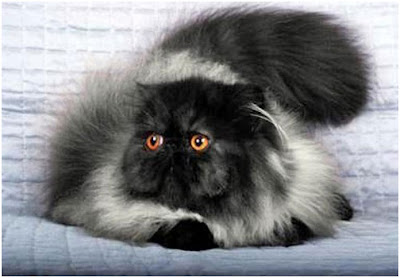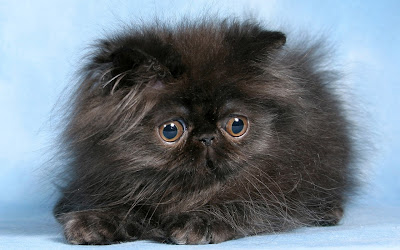Black Persian Cat - The fur of longhair cats can be up to ten times longer than that of a shorthair. Most pedigreed cats are the various types of Persian. They were probably the result of mating early types of Angora cats from Ankara in Turkey with the original Persian cats from what is now Iran. The longhair coat has an underlying layer of soft hairs topped by longer, coarser guard hairs.
Although many longhairs are fastidious about their grooming, they need extra help from their owner on a daily basis, even if they are not going to be entered for shows. Another consideration for potential owners is that longhairs tend to moult all year round, leaving fur on carpets and furniture.
Their bodies are broad chested with sturdy legs and large paws, and they all have a soft, thick fur coat with a distinctive ruff around the neck, and a full, low slung tail. Persian longhairs come in many different colors and patterns.
In some countries, such as the United States, the color variations are considered as varieties of the same breed, but in Britain, each different color is listed as a separate breed. Persian cats are among the longest known pedigreed cats.
Longhaired variations of wild species may have spontaneously occurred in colder regions in the heart of Asia, and then gradually become established with subsequent interbreeding. The ancestors of today’s Persian were probably stocky, longhaired grey cats brought to Europe from Persia (now Iran) in the 1600s and silken haired white Angora cats from Turkey (a different type from the modern Angora breed). Today, there are over 60 different color variations of the Longhair Persian type.
The Persian cat breed has several variations, notably in terms of color, appearance, and behavior or temperament. Interested pet owners, particularly cat owners, need to learn about these differences in order to properly care for their pet. In the case of black Persian cat, it is somewhat shrouded in mystery because most people often hear or read about it in novels, particularly those released during the Ayudhya period (ranging from 1350 to 1767). Since then, the knowledge of black Persian cat has evolved but their charm to pet owners and enthusiasts have never ceased.
The Black Persian cat is quite a rare type of cat, though. In fact, it is probably the most rarely photographed breed amongst the Persian cats. It does have a variation though known as the Moggie black, which is becoming far more common these days. The fascination for black Persian cats spring from the superstition associated with black cats in general. It is either viewed as lucky or unlucky, depending on one’s belief system. There is no doubt a mass of superstition involved in dealing with black cats and that holds true with Persian black cats, as well.
According to history of the spread and growth of the black Persian cat breed, its propagation started in the 1930’s at the United States. A health practitioner was believed to have carried Wong Mau, a female black Persian cat, from Burma until the cat mated with a Siamese cat, which is believed to have resulted in the variant shades featured in different cat breeds. This mating process also resulted to the propagation of black Persian cats, which continued to breed until late 1940’s wherein it has reached the British Isles. In fact, Britain officially acknowledged this particular breed of cat in the year 1952.
When it comes to the temperament of the black cat variation, they are known to be full of energy. For this same reason, they have the tendency to become irreverent, especially when not in the best of moods. But one admirable trait about this breed of Persian cat is that they are excessively clever. Upon initial encounter with this cat, they will act awkward but once they have gotten familiar with a person, then it won’t be long until their true personalities are revealed.
Black Persian Cats typically have large faces with a velvety, purple foot. It might take a skilled individual to urge and have these cats interact with them, using polite comments and smoothly caressing the cat. One thing is for sure though, this breed of cat is not the noisy type. Hence, you can expect a black Persian cat to engage with normal folks and is an ideal choice for a family pet.
Due to their cleverness, these cats might exhibit sulking whenever their owner starts becoming obtuse. Nonetheless, don’t expect this sulking to last for an extended period of time. It is therefore not the type of breed that would fit the untamed because it much prefers to stay safe inside your home.
Black Persian Cat breed information :
Coat – thick, lustrous, full frill at neck and shoulders
Eyes – copper or deep orange, rims black
Other features – nose leather and paw pads black
Grooming – demanding, thorough, daily
Temperament – placid













